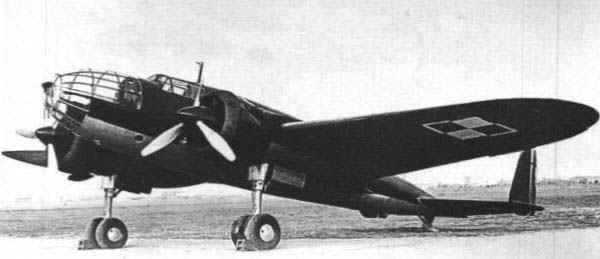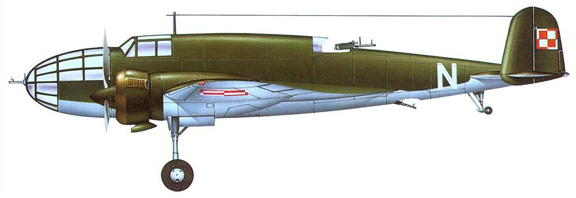|
|



|
Type: Four-Seat medium bomber Origin:PZL (National Aero Factory) First Flight: June 1936 Service Delivery: N/A Final Delivery: N/A Number Produced: N/A Engine: Type: PZL (Bristol) Pegasus XX Radial Number: Two Horsepower: 925 hp Dimensions: Wing span: 58 ft. 10.75 in. (17.95m) Length: 42 ft. 4.75 in. (12.92m) Height: 16 ft. 8.25 in. (5.09m) Wing Surface Area: 575.89 ft. (53.50 m²) |
Weights: Empty: 9,436 lbs. (4280 kg) Max. Take-Off: 19,621 lbs. (8900 kg) Performance: Maximum Speed: 277 mph (445 km/h) Initial climb: N/A Service Ceiling (No Bombload): 30,000 ft. (9145m) Range (With Bomb Load): 932 Miles (1500 km) Armament: P.23: One 7.7mm (.303 in.) machine guns in nose, dorsal and ventral positions. Bomb Load: Up to 5,688 lb. (2580 kg.) carried internally |

|
Design and development: - Source: Wikipedia Sometimes the plane is called "PZL P-37" or "PZL P.37", but the letter "P" was generally reserved for fighters of Zygmunt Pulawski's design (see PZL P.11). Correct designation is PZL.37. The PZL.37 was designed in the mid-1930s at the PZL factory in Warsaw by Jerzy Da;browski. The first prototype, fitted with a single vertical stabilizer, flew on December 13, 1936. The second prototype PZL.37/II, with twin vertical stabilizers and other improvements, was accepted for production. The first 10 serial aircraft were produced in 1938 as the PZL.37A variant with a single vertical stabilizer, however. The next 19 interim aircraft were built as PZL.37A bis, with a twin tail. They all were powered by Bristol Pegasus XII B radial engines produced in Poland under licence. The main production variant, the PZL.37B (or: Łoś II), was fitted with the twin tail and newer Pegasus XX engines. Production of PZL.37B for the Polish Air Force started in autumn 1938. During the initial period of PZL.37 service, 2 prototypes and 6 serial planes, were lost in crashes caused by technical problems, mostly with rudders. After some structural changes, the PZL.37B became a fully reliable aircraft. By the outbreak of World War II, about 92 PZL.37s had been produced and given to the Air Force, and a further 31 were in different phases of production. Before the war, the PZL.37B Łoś was one of the world's most modern bombers. It was able to carry a heavier bombload than similar aircraft, for example the Vickers Wellington though the size of the bombs was limited. Smaller than most contemporary medium bombers, it was relatively fast and easy to handle. Thanks to a landing gear with double wheels it could operate from rough fields or meadows. Typically for the late 1930s, its defensive armament consisted of only 3 machine guns, which proved too weak against enemy fighters. Starting with a presentation at a salon in Belgrade in June 1938 and in Paris in November, the PZL.37 met with a huge interest. For export purposes, new variants were developed: the PZL.37C with Gnome-Rhô:ne 14N-0/1 engines of 985 cv (971 BHP, 724 kW), maximum speed 445 km/h and the PZL.37D with 14N-20/21 of 1,065 cv (1,050 BHP, 783 kW), maximum speed 460 km/h. In 1939, 20 PZL.37Cs were ordered by Yugoslavia, 15 by Bulgaria, 30 PZL.37D by Romania and 25 by Turkey and Belgium ordered a license. Also several other coutries were negotiating. The outbreak of the war prevented the production of these aircraft. At that time, PZL developed the next variant for the Polish airforce, the PZL.49 Mis', but this was not completed before the war. Having slightly bigger dimensions, Mis' ("Bear") was to be fitted with Bristol Hercules II engines of 1,350 BHP (1,370 cv, 1,007 kW), maximum speed 520 km/h and an upper turret.
Technical design - Source: Wikipedia
Operational history - Source: Wikipedia Only the PZL.37s of the Bomber Brigade took part in combat. By September 1, they had been deployed to rural improvised airfields, so they were not destroyed on the ground by the Germans in their initial attack on the main Polish airbases. During the Invasion of Poland, from September 4 onward the planes of the Bomber Brigade were attacking German armoured columns in day attacks, forced by the desperate situation to perform this mission for which they were not designed (the original plans to bomb targets inside Germany were quickly abandoned). Most notably, they hampered the advance of the 16th Armoured Corps near Cze;stochowa and Radomsko. They suffered heavy losses due to lack of fighter protection, especially, that they usually acted in no more, than three aircraft at a time. Last combat flights took place on September 16. During the campaign, the combat units were reinforced with several other aircraft, and about 46 PZL.37s were used in combat. Of Bomber Brigade, 10 PZL.37s were sh ot down by fighters, 5 shot down by enemy anti-aircraft artillery, two bombed on the ground and a further 10 lost in other ways. A number of not fully completed, training or reserve PZL.37s were also destroyed on airfields and in factories (18 PZL.37s were bombed in a reserve base in Małaszewicze and in a factory in Warsaw - Okęcie). 26 or 27 PZL.37s (17 from the Bomber Brigade and 10 training ones) were withdrawn in 1939 to Romania. In October 1940 they were seized by the Romanian government and 23 were next used by the Romanian airforce in the 4th Group, consisting of the 76th and 77th bomber escadres. Some were uparmed with 4 machineguns (the Polish PWU machineguns were still used). About 1/3 were lost in crashes due to lack of experience of Romanian pilots with PZL.37 handling and its high wing loading, and due to engine faults. About 15 were used against the USSR from June 22, 1941. Among others, they first operated in Bessarabia, then they were bombing Kiev and Odessa. Some were lost, mostly due to anti-aircraft fire. Because of lack of spares, the remaining ones were withdrawn from the front in October 1941 and used for training. In April 1944, the 76th escadre returned to combat, with 9 aircraft, but it was withdrawn from the front on May 3, 1944. After Romania joined the allies, on September 1, 1944 the G erman aircraft destroyed 5 PZL.37s on a ground. Captured planes were also tested in Germany and the USSR. Not many PZL.37s, however, fell into German hands (probably only two), because Polish workers scrapped about 30 PZL.37s remaining in factories in Okęcie and Mielec in October 1939, under pretext of cleaning up the area, before the competent German authorities were able to reconnoitre. There are no surviving PZL.37 aircraft currently. Variants - Source: Wikipedia PZL.37/I - First prototype with a single tail fin. PZL.37/II - First prototype with a double tail fins and improvements. PZL.37A - First 10 serial aircraft with single tail, Bristol Pegasus XIIB engines. PZL.37Abis - Batch of 19 serial aircraft of A version with double tail fins. PZL.37B - Main production variant with twin tail fins and PZL Pegaz XX engines. PZL.37C - Planned version with Gnome-ô 14N-0/1 engines. PZL.37D - Planned version with Gnome-Rhône 14N-20/21 engines. |

